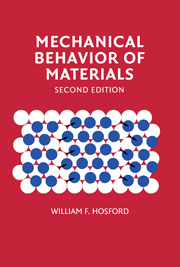Book contents
- Frontmatter
- Contents
- Preface
- 1 Stress and Strain
- 2 Elasticity
- 3 Mechanical Testing
- 4 Strain Hardening of Metals
- 5 Plasticity Theory
- 6 Strain Rate and Temperature Dependence of Flow Stress
- 7 Slip and Crystallographic Textures
- 8 Dislocation Geometry and Energy
- 9 Dislocation Mechanics
- 10 Mechanical Twinning and Martenitic Shear
- 11 Hardening Mechanisms in Metals
- 12 Discontinuous and Inhomogeneous Deformation
- 13 Ductility and Fracture
- 14 Fracture Mechanics
- 15 Viscoelasticity
- 16 Creep and Stress Rupture
- 17 Fatigue
- 18 Residual Stresses
- 19 Ceramics and Glasses
- 20 Polymers
- 21 Composites
- 22 Mechanical Working
- APPENDIX I Miller Indices
- APPENDIX II Stereographic Representation of Orientations
- Index
9 - Dislocation Mechanics
Published online by Cambridge University Press: 05 June 2012
- Frontmatter
- Contents
- Preface
- 1 Stress and Strain
- 2 Elasticity
- 3 Mechanical Testing
- 4 Strain Hardening of Metals
- 5 Plasticity Theory
- 6 Strain Rate and Temperature Dependence of Flow Stress
- 7 Slip and Crystallographic Textures
- 8 Dislocation Geometry and Energy
- 9 Dislocation Mechanics
- 10 Mechanical Twinning and Martenitic Shear
- 11 Hardening Mechanisms in Metals
- 12 Discontinuous and Inhomogeneous Deformation
- 13 Ductility and Fracture
- 14 Fracture Mechanics
- 15 Viscoelasticity
- 16 Creep and Stress Rupture
- 17 Fatigue
- 18 Residual Stresses
- 19 Ceramics and Glasses
- 20 Polymers
- 21 Composites
- 22 Mechanical Working
- APPENDIX I Miller Indices
- APPENDIX II Stereographic Representation of Orientations
- Index
Summary
Introduction
Once the concept of dislocations was accepted, there were three important questions to be answered. First, when a single crystal is deformed, slip occurs with shear offsets of thousands of atom distances on relatively widely spaced planes, rather than uniformly throughout the crystal. See Figure 9.1. Why does slip not occur uniformly at an atomic scale?
Second, cold working increases the dislocation content of crystals even though dislocations must run out of the crystals. See Figures 9.2 and 9.3. Where do the additional dislocations come from?
Third, the yield stress increases as the number of dislocations increases even though without any dislocations, the strength would be even higher. See Figure 9.4. Why does the yield stress increase with dislocation density?
Frank-Read Sources
The first two questions can be answered in terms of the Frank-Read source, which generates dislocations. Suppose that there is a finite length of a dislocation, AB, in a slip plane (Figure 9.5). The dislocation leaves the plane at A and B, but the end points are pinned at A and B. A shear stress, τ, acting on the plane, will create a force that causes dislocation to bow. This bowing is resisted by the line tension of the dislocation. As the shear stress is increased, the dislocation will bow out until it spirals back on itself. The sections that touch annihilate each other, leaving a dislocation loop that can expand under the stress and a restored dislocation segment between the pinning points. The process can repeat itself, producing many loops.
- Type
- Chapter
- Information
- Mechanical Behavior of Materials , pp. 155 - 165Publisher: Cambridge University PressPrint publication year: 2009



